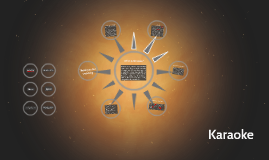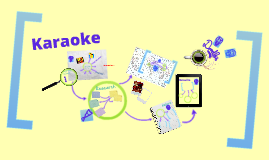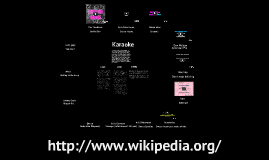Karaoke
Transcript: Karaoke Also known as Minus-One in the Philippines, is a form of interactive entertainment or video game in which amateur singers sing along with recorded music (a music video) using a microphone and public address system. The music is typically a well-known pop song minus the lead vocal. Lyrics are usually displayed on a video screen, along with a moving symbol, changing color, or music video images, to guide the singer. In some countries, a karaoke box is called a KTV. It is also a term used by recording engineers translated as "empty track" meaning there is no vocal track 1960 Development of audio-visual-recording devicesFrom 1961–1966, the American TV network NBC carried a karaoke-like series, Sing Along with Mitch, featuring host Mitch Miller and a chorus, which superimposed the lyrics to their songs near the bottom of the TV screen for home audience participation.[2] The primary difference between Karaoke and sing-along songs is the absence of the lead vocalist.[citation needed] Sing-alongs (present since the beginning of singing) fundamentally changed with the introduction of new technology. In the late 1960s and into the 1970s, stored audible materials began to dominate the music recording industry and revolutionized the portability and ease of use of band and instrumental music by musicians and entertainers as the demand for entertainers increased globally. This may have been attributable to the introduction of music cassette tapes, technology that arose from the need to customize music recordings and the desire for a "handy" format that would allow fast and convenient duplication of music and thereby meet the requirements of the entertainers' lifestyles and the 'footloose' character of the entertainment industry. 1980 Development of the karaoke machineThere are various disputes about who first invented the name karaoke. One claim is that the karaoke styled machine was invented by Japanese musician Daisuke Inoue[3] in Kobe, Japan, in 1971.[4][5] After becoming popular in Japan, karaoke spread by to East and Southeast Asia during the 1980s and subsequently to other parts of the world. In Japan, it has long been common to provide musical entertainment at a dinner or a party. Japanese drummer Daisuke Inoue was asked frequently by guests in the Utagoe Kissa, where he performed, to provide recordings of his performances so that they could sing along. Realizing the potential for the market, Inoue made a tape recorder-like machine that played songs for a 100-yen coin each. Instead of giving his karaoke machines away, Inoue leased them out so that stores did not have to buy new songs on their own. Originally, it was considered a somewhat expensive fad, as it lacked the live atmosphere of a real performance and 100 yen in the 1970s was the price of two typical lunches, but it caught on as a popular kind of entertainment. Karaoke machines were initially placed in restaurants and hotel rooms; soon, new businesses called karaoke boxes, with compartmented rooms, became popular. In 2004, Daisuke Inoue was awarded the tongue-in-cheek Ig Nobel Peace Prize for inventing karaoke, "thereby providing an entirely new way for people to learn to tolerate each other."[6] 1990 Karaoke soon spread to the rest of Asia and other countries all over the world. In-home karaoke machines soon followed but lacked success in the US and Canadian markets. When creators became aware of this problem, karaoke machines were no longer being sold strictly for the purpose of karaoke but as home theater systems to enhance television watching to "movie theater like quality". Home theater systems took off, and karaoke went from being the main purpose of the stereo system to a side feature. As more music became available for karaoke machines, more people within the industry saw karaoke as a profitable form of lounge and nightclub entertainment. It is not uncommon for some bars to have karaoke performances seven nights a week, commonly with high-end sound equipment superior to the small, stand-alone consumer versions. Dance floors and lighting effects are also becoming common sights in karaoke bars. Lyrics are often displayed on multiple TV screens around the bar. Lady gaga You and i Adele Rolling in the deep Johnny Cash Ring of fire Queen Bohemian Rhapsody Kelly Clarkson Stronger (What dosen't kill you) Neil Diniomand Sweet Caroline Eurythmics Sweet dreams are made of this Aqua Barbie girl Journey Don't stop beliving Don Mclean American Pie Bruno Mars Grenade Gym Class Heros Stereo Hearts The Trashmen Surfin Bird http://www.wikipedia.org/

















